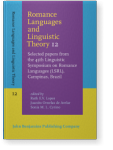Chapter 4
Aktionsart and event modification in Spanish adjectival passives
I observe that the Aktionsart of the underlying VP within the participle plays a key role in the (un-)availability of event-related modification in Spanish adjectival passives: telic VPs disallow event-related modifiers, but stative causative VPs allow them. I adopt a temporal syntax framework (Demirdache & Uribe-Etxebarria 2000 et seq) for the structure of the VP, and propose that the temporal argument (EV-T) of telic verbs is external to the VP. Adjectivization happens before EV-T projects and thus the event is not spatio-temporally instantiated, effectively barring event-related modification. Stative causatives’ temporal argument is internal to the VP and thus adjectivization cannot prevent its projection.
Article outline
- 1.Introduction
- 2.
Aktionsart and event-related modification: The data
- 3.The proposal
- 3.1The theoretical background
- 3.3Severing the EV-T argument from its verb
- 3.4Apparent counter-examples: Gehrke’s event kinds
- 4.Conclusions
-
Notes
-
References
